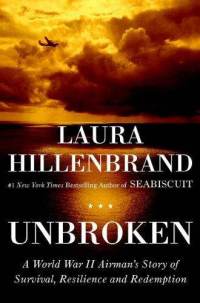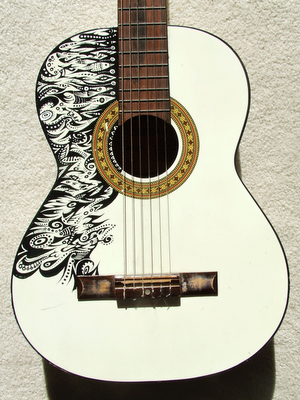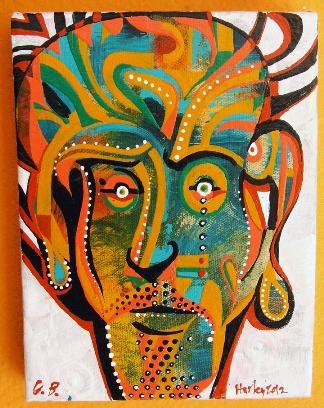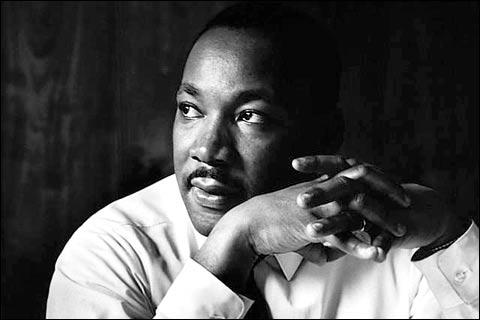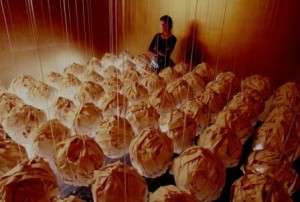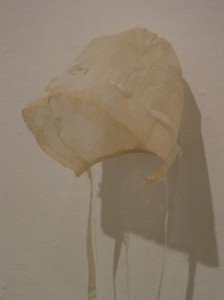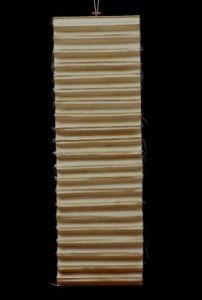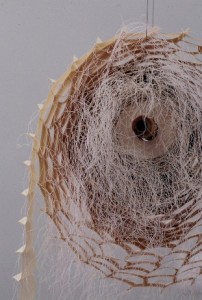Unbroken
Laura Hillenbrand
A World War II Story of Survival, Resilience and Redemption
On a May afternoon in 1943, an Army Air Forces bomber crashed into the Pacific Ocean and disappeared, leaving only a spray of debris and a slick of oil, gasoline, and blood. Then, on the ocean surface, a face appeared. It was that of a young lieutenant, the plane’s bombardier, who was struggling to a life raft and pulling himself aboard. So began one of the most extraordinary odysseys of the Second World War.
In her long-awaited new book, Laura Hillenbrand writes with the same rich and vivid narrative voice she displayed in Seabiscuit. Telling an unforgettable story of a man’s journey into extremity, Unbroken is a testament to the resilience of the human mind, body, and spirit.
-From Goodreads
View the book trailer
In the Name of Honour
Artist Faiza Khan
Faiza Khan is a Pakistani artist and activist. Her exhibition ‘In the Name of Honour’ focused on the horrendous crime of torturing and executing women for perceived immoral behavior. Through her art and non-profit advocacy organization, Rastay, Faiza collaborates with others to bring about social justice for women and to build a better Pakistan.
View more of Faiza Khan’s artwork on her website.
Learn about her advocacy organization, Rastay.
Life is Beautiful
Keb’ Mo’
So easily forgotten, are the most important things
Like the melody and the moonlight in your eyes
And the song that lasts forever, keeps on gettin betta
All the time
Cuz life is beautiful
Life is wonderous
Every star above is shining just for us
Life is beautiful, on a stormy night
Somewhere in the world the sun is shining bright.
More from Keb’ Mo’
Artist Sean Michael Hurley
I always counsel people on the power of repetitive doing. It’s ironic, because this is always the source of profoundly deep and personal style. You can feel the electricity as surely as you’re watching a world-class athlete when someone is really flowing in whatever their media. That kind of power is only found through diligent practice. You do the work, the duendé will give you the voice.
Fisherman, restaurant worker, in-home caregiver, sales agent, landscaper, bouncer, counselor, teacher, band frontman – all of these words can describe Sean Hurley at different snapshots of his varied life. But throughout the years, the common thread has always been the creation of art as a way to express his life experiences and feelings. Born and raised in the Northwest, Sean lives with his wife and daughter in Seattle. Recently he took time out from his busy life to share some of his artistic journey with Healing Hamlet.
 Sean, thank you for visiting with us. When did you first know you wanted to be an artist?
Sean, thank you for visiting with us. When did you first know you wanted to be an artist?
My mother bought me comic books when I was very young. I drew those characters, all so rich and vivid in my imagination. Batman and Spiderman were alive to me, and I wanted to document that. But I loved music and singing also and was probably more compelled by those impulses. However, in second grade we participated in a Bicentennial art contest. We were to draw our patriotic second-grade posters, which would be judged. A winner would be named, an award awarded. Derek Jeffries sat to my left, and he was working up a rather nice little eagle. It has always been my talent to spot potential in an image which is underdeveloped. I merely upgraded Derek’s eagle into something with a little more bravado: I cleverly inscribed ” Oh Butiful America” over my glorious avian beast — and I was awarded the grand prize, a $25.00 savings bond, which later helped fund my first trip abroad. I received the praise of every teacher I saw, a definite first, and it seemed impolite not to assume the mantle of class artist. Things just kind of rolled on from there.
How would you describe your artistic style?
I’ve worked in a variety of ‘voices’ over time, which is necessary for anyone who is serious about a practice. The notion of a personal style or voice is strangely overvalued in many quarters of our culture; it presumes that people need to seek out guidance to have their own perspective, which is ludicrous. People do not need help finding their differences; we need help learning to share them in the most imaginative ways we can muster. So I’m a big fan of art as practice, whereas style is often more about how things look.
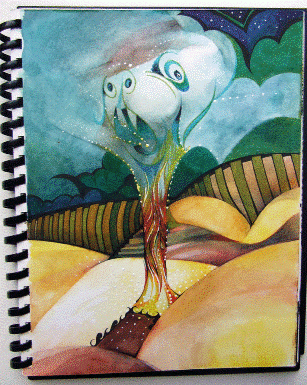 What projects and materials do you prefer to work with?
What projects and materials do you prefer to work with?
I have a thing about lives and patterns. That being said, my workspace really determines what I’m working on. I currently have very little designated workspace, therefore my graphic work is small, drawings mostly, with all sorts of little rules and reasons. I have all sorts of stuff created from mini-manias: masks, music, dolls with new sculpey heads… I’m thinking about leaning to sew. I look for that marvelous feeling, not in the work itself, but in one’s relationship to a piece of work.
You have the unique opportunity of working with people in crisis at the Seattle DESC (Downtown Emergency Service Center). Have you found a way to integrate your artistic talents into this position? When have you experienced art to be healing for the DESC residents?
This topic is very close to my heart, and it is a huge thing to mull over. I will say: Yes, and often. For example, I copied a book of my drawings for clients to use as coloring pages, which is a very meditative activity. I will also sing to and with clients to soothe them.
Any other times where you witnessed art to be healing?
It’s a funny question; are your lungs healing? Is your voice healing, or your accent? Your taste in movies, or your choice in a spouse? Art is like that. What is truly healing is finding a practice that connects you, that produces harmony, which can be measured in many different ways (if you’re the measuring type). I always counsel people on the power of repetitive doing. It’s ironic, because this is always the source of profoundly deep and personal style. You can feel the electricity as surely as you’re watching a world-class athlete when someone is really flowing in whatever their media. That kind of power is only found through diligent practice. You do the work, the duendé will give you the voice.
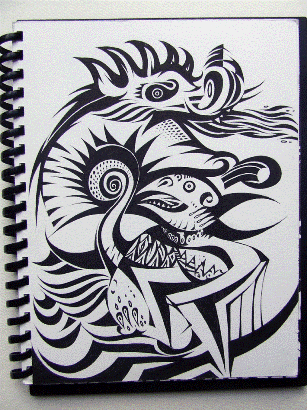 What is your involvement in the local art community?
What is your involvement in the local art community?
I am lucky enough to have not only many truly wonderful friends, but totally brilliant ones. My community of friends in Seattle are so diverse, and so amazingly productive in so many ways… I’m mostly in awe of a lot of them.
You are also a musician. Can you tell us what you’re doing in music?
I’ve always written little folk songs, but I joined a band back in October called Sova, and it’s maybe the most fun thing I’ve ever done. I’m singing, which I have been terrified to do publicly my entire life. I’m writing lyrics, when I hate how banal they always seem, how they’re never just right. I also do all the band graphics. In the process, I found great friends who value work and fun, and we have this totally loud Rawk band. I think we’re going to try and play at the Hard Rock Cafe for our first show in a ‘battle of the bands!’ Are you all laughing? Because this all really cracks me up — it’s like playing a prank or being in a small, weird theater production. Now that is what Art should be like.
What artists inspire you?
They always change. I’m a gigantic Neil Gaiman fan, and I think his Sandman epic is wonderful literature; he worked with tons of fantastic artists as well. I love Tom Waits and the whole persona he’s created, all wrapped around such beautiful songs. The Beatles have always been a source of unflagging joy. Milton Glaser – I’ll never get to study with him, but my dear friend Bob Perlman did. Bob Perman and Robert Hardgrave, two good friends that I don’t see nearly enough, are my two favorite living painters. Jim Woodring, a close, close friend and a mentor, a genius cartoonist whose cartoons have evolved into an allegory on par with William Blake. Heck, I’m not even scratching the surface.
Music, drawing, writing, teaching. I do a fair amount of teaching, but not in anything related to the arts. I do regular presentations on the intersection of spirituality and social work, preparing potential Peer Specialists for their certification, which is what I do. I counsel suicidal and psychotic people 40 hours every week. It’s a pretty loaded dance card.
Where would you love to see yourself and your work in the future?
I sort of consider myself a talented amateur at this point; I make stuff all the time, but my focus now is primarily in integrating my life as much a possible, making hitherto disparate aspects of my creativity come together in new ways. I’m not really showing much, or publishing, or getting grants or write-ups, but I feel as confident as I ever have in the work I do, in whatever the medium. So I’m mostly just a scenester.
I’d love to see myself in a state of pretty regular joy. I care about the posterity of my work only insomuch as hoping it one day might provide a little pride in my descendants. Mostly I just want to follow my path.
Follow Sean Michael Hurley on his blog
Listen to Sean’s band, Sova, on their website
Each Little Bird That Sings
Deborah Wiles
Ten-year-old Comfort Snowberger has attended 247 funerals–her family owns the local funeral home, after all. And even though Great-uncle Edisto keeled over with a heart attack and Great-great-aunt Florentine dropped dead–just like that–six months later, Comfort knows how to deal with loss, or so she thinks. She’s more concerned with avoiding her crazy cousin Peach and trying to figure out why her best friend, Declaration, suddenly won’t talk to her. But life is full of surprises. And the biggest one of all is learning what it takes to handle them.
In this heartfelt and quintessentially Southern coming-of-age novel, Comfort will charm young readers with her wit, her warmth, and her struggles as she learns about life, loss, and ultimately, triumph.
-From Goodreads
Learn more about this award winning book for all ages here.
Infinite Hope
“We must accept finite disappointment, but never lose infinite hope.”
-Martin Luther King, Jr.
Anyway
People are illogical, unreasonable, and self-centered.
Love them anyway.
If you do good, people will accuse you of selfish ulterior motives.
Do good anyway.
If you are successful, you will win false friends and true enemies.
Succeed anyway.
The good you do today will be forgotten tomorrow.
Do good anyway.
Honesty and frankness make you vulnerable.
Be honest and frank anyway.
The biggest men and women with the biggest ideas can be shot down by the smallest men and women with the smallest minds.
Think big anyway.
People favor underdogs but follow only top dogs.
Fight for a few underdogs anyway.
What you spend years building may be destroyed overnight.
Build anyway.
People really need help but may attack you if you do help them.
Help people anyway.
Give the world the best you have and you’ll get kicked in the teeth.
Give the world the best you have anyway.
-Kent M. Keith
At This Point In My Life
Tracy Chapman
At this point in my lifeI’ve done so many things wrong
I don’t know if I can do right
If you put your trust in me
I hope I won’t let you down
If you give me a chance I’ll try.
At This Point In My Life from the album New Beginning
Video created by Steve Walker
Artist Stephanie Speight
“The act of creating is critical to my personal well being. It is the avenue through which I approach everything. I am simply not happy if not engaged in the act of manipulating materials toward some new end.”
Stephanie Speight credits her upbringing on an Oregon farm for her love of nature, gardening, food preparation and the need to be resourceful. She has brought this history into her work as a chef and an artist who creates new life out of old things.
Stephanie attended Oregon State University, majoring in foods and nutrition, but gravitated to art classes whenever her schedule allowed. She worked in clerical positions and in commercial kitchens, putting her interest in art on hold while raising a family. In 1994, she returned to school and earned her BFA at Marylhurst College. She currently works as a pastry chef at New Season’s market and has an upcoming art show scheduled for August at the Nine Gallery in Portland, Oregon.
Stephanie, when did you know you wanted to be an artist? What drew you to create?
I never thought about using the word “artist” to describe myself. That word I reserved for Ann Hamilton, Eva Hesse, Richard Tuttle, Agnes Martin… some of my idols. What I did know was that I loved to mess around and when I messed around two things happened. I completely lost myself, and something appeared that I could not have possibly thought up had I not been “lost”. Being in that “empty space” was what I wanted more of, and my formula for getting there was found in the act of manipulating materials. I needed to learn more about materials.
Raising children while hanging out in the “empty space” doesn’t always work well. Once the kids were pretty much on their way, I got the green light and off I went to Marylhurst to get my degree in “messing around”. Even to this day, that word “artist” seems lofty.
I pretty consistently gravitate toward used or found materials. There is something I find deeply satisfying in rescuing, reusing, repurposing, “stuff” that already exists, as opposed to adding new “stuff” to a world that’s already so full of “stuff”.
What was the most challenging project you ever did and why?
That would be a show at Archer Gallery, the title of which was, Sunny Valley Oregon Ecole de Couture, an exhibition of garments sewn using tissue paper. I had been mindlessly sewing away using old patterns from the 50’s in conjunction with an old moth eaten roll of tissue paper without thought of why or where this might lead. I was learning to sew in a most challenging way and when I finished the first dress, I was so carried off by its fragile nature and the way in which light played with the paper, I promptly started cutting out another. With the completion of each, I’d let down a bar, via a crude pulley arrangement I’d rigged up in our living room, and hang the garment there. Over a period of a year, the collection of 1950’s style garments inhabited the upper reaches of the living room like a gathering of ghosts.
The curator for the Archer Gallery at Clark College, Margery Hirsch (now retired), was very interested in what I was doing and wanted to give me a show. Carried off by her enthusiasm, I agreed without really thinking it through. The gallery at Clark was a large windowless (basement) space which kindled an interest in illuminating the garments from within. As time marched on, I was confronted by so many technicalities: there were expenses, and the stipend from Clark wasn’t huge. How on earth was I going to pull it off? That particular time was challenging as I had Mom on my mind and getting her into a safer situation. My brain was split down the middle. I tried several times to get out of doing this show as I was feeling overwhelmed, but Margery was just so supportive, encouraging and helpful that I trudged on. It took me two years before the show came together with the help of friends, the Artist Trust and the college, and it was well received.
You cared for your mother for several years as her health declined and then lost her this past spring. How was the creation or experience of art healing for you during this time?
I had a show at the Nine Gallery in Portland which dealt with old trim work from houses being demolished. That show was about repurposing old painted wood. People were surprised. Where was the lovely paper? The impetus for that work came from a need to spend time in the garage instead of in my little studio space (a 10 x 10 former bedroom) in the house. Mom took to whistling about 6 months after we moved her in. She whistled every waking minute, unless she was eating. She couldn’t help herself. It had to do with the progression of her dementia, and I tried everything I could think of, or that was recommended to stop it – to no avail. I found my escape in head phones & power tools: table saw, belt sander, chop saw, etc.
The best single example of “art as healing” as it pertains to my creative journey circles back to Mom and her whistling. As sweet as whistling can be, to have it nonstop in the center of your house is equivalent to Chinese water torture. It drove me stark raving crazy! I cannot adequately put into words the cumulative effect of 6 years of nonstop whistling. I had tried so many ways to deal with it, and finally hit upon a plan to turn a negative into a positive. Borrowing a video camera from a friend and video artist, Horia, I set it up in the house. Whenever Mom was up, I’d flip it on, capturing action and the whistling. This I continued for several weeks. I caught her in all sorts of situations: reading the paper, visiting, watching TV, sorting buttons, knitting, etc. – all the while whistling. The camera was returned to Horia’s studio and the plan was that he would assist me in the editing process, and perhaps I’d come up with something meaningful in the end. Six months passed and one day Horia called saying he’d been watching some of the footage and that I should come down to his studio. I wasn’t anxious to comply, as I was still living with it day to day. Why would I want to drive across town to listen to more? But I did. It was the most amazing experience! I was observing the phenomenon from a whole new perspective and it was hauntingly beautiful. This “thing” that had nearly driven me off a cliff, was now so utterly profound.
After the experience in Horia’s studio I was less tortured by Mom’s obsession. Over the next 2 years, her repertoire of songs shrunk, and there would be times of silence. In the last year Mom stopped whistling. The silence seemed huge. She was such a sweet sweet thing and I miss her.
What places, artworks or artists do you turn to for inspiration?
I look for inspiration right under my nose, or mostly in stuff I drag home. I have an affinity for artists working conceptually or classed as minimalists (Agnes Martin, Donald Judd, Ann Truitt). Installation art is also at the top of my list (Ann Hamilton). I have a few close artist friends that I spend time with – they keep needling me.
As an artist, what is ahead for you in 2013?
The act of creating is critical to my personal well being. It is the avenue through which I approach everything. I am simply not happy if not engaged in the act of manipulating materials toward some new end.
I have a show scheduled for 2013 on which I’ve not begun. Garments are still of interest, and instead of paper I have two old sails that my uncle Pat gave me about a year ago (he was a sailor). I have sewn one shirt using a chunk of one sail, and showed that piece in a group show last September. The desire to create another collection of garments is strong. We’ll see if that happens . . .
Stephanie, thank you for sharing your story with Healing Hamlet. We look forward to seeing more of your work at Portland’s Nine Gallery this coming August!
